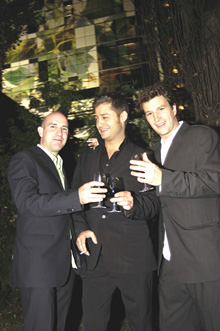Leafy exterior mural will become a downtown landmark

From left, Hans Brown, Nicolas Baier and Bruno Braer. Brown and Braer comprise Cabinet Braun-Braër.
Photo by Luigi D'Astolofo
The leafy mural gracing the Mackay St. façade of the Integrated Engineering, Computer Science and Visual Arts Complex is complete.
When it was briefly spotlit at a formal introduction to the public on Sept. 28, the spaces within its grid that are dark in daylight appeared in all their translucent glory. The mural, depicting sections of a deconstructed plant, will be permanently lit at night after the building is finished.
Although the mural’s grid-based composition bears something in common with the look of some of his past works, the artist, Nicolas Baier, pointed out, “Every time I’ve used a grid, I’ve functioned very differently on the methodological level of the work.”
The divisions, or splices, in his photographs take on different purposes from one piece to the next. In this case, the grid fulfills a purely formal purpose. “It’s a collapsed point of view.” The composition forces the eye to rummage through, skip over and piece together an image in the mind.
Baier didn’t deny being proud of having, with the design team Cabinet Braun-Braën, won the competition for the contract. This is far from being his first coup, though.
Baier’s work is familiar to followers of visual arts in Quebec. He won the Prix Pierre Ayot in 2000, and had an exhibition in 2003 at the Museum of Contemporary Art. There’s a piece of his at the Montreal Museum of Fine Arts, and private collectors buy his work through the René Blouin Gallery.
He has built a career that allows for the creative latitude he insists on. His creative modus operandi is simple, but very broad.
“I ask myself if it works or not, or if it touches me. That’s all. I won’t close any doors, and I try to never do the same thing over. It has to be different all the time. Otherwise it would be boring, and I would stop producing.”
His uncompromising take on work had to cross some hurdles with this project, though. Consensus on the entry had to be reached between a creative team of three. Baier had his doubts about their final choice, which he produced after a long process of brainstorming and debate, but his team members and his agent, René Blouin, loved it. The image was submitted, and the contract was won.
Discussion between the artist and Concordia over a stipulation that the mural not be visible from the interior of the building led to a compromise that Baier could live with: 15 to 20 per cent of the work is transparent. The mural will not be visible from the studios, but the windows of certain public spaces will have a vaguely stained-glass effect.
Although there were expenses that would not be incurred in most art works (a creative team of three, and lawyers’ fees, for example), and the project was two years in the making, at a total cost of $475,000, the payment to the artist is significant. (Consider that the average annual income of visual artists in Canada is $12,633.) Baier stresses that he is interested in reality, or more precisely, what he calls "multi-realities" that include aspects of life not usually visible to the naked eye, or lens: the world of sleep, dreams, memory, and altered states of consciousness.
This 6,000-square-foot mural has effectively bought Baier some time to play with. He is not scheduling any exhibitions in the near future. His advice to younger artists makes sense if you accept that creative work cannot be forced. "You have to work very hard, and be very lazy."
To see more of Baier's work, visit his website at www.nicolasbaier.com or see a short interview in QuickTime at the web site for CBC's Zed: http://zed.cbc.ca/go